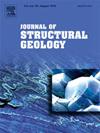Mineral heterogeneity dominates the tensile failure mode of Eastern Himalayan Gneiss
IF 2.9
2区 地球科学
Q2 GEOSCIENCES, MULTIDISCIPLINARY
引用次数: 0
Abstract
As two fundamental fracture types in rock engineering, tension and shear fractures are commonly considered to operate under different stress conditions. However, abundant recent research shows that the microscale heterogeneity of rocks leads to the possibility of microscale tensile and shear fracturing under any stress state. In particular, localised stress concentrations and tensile fractures caused by mineral heterogeneity under compressive stress have been widely studied. However, the heterogeneity-induced processes involved in the shear fracture under direct tension conditions remain ambiguous. In this study, a micro-direct tensile test was used to comprehensively reveal the process and mechanism by which mineral heterogeneity leads to shear fracture in the gneiss of the eastern Himalayas under direct tension. Microscopic observation of the failure process under direct tension, normalised crack initiation and propagation stress, and transverse strain dilation caused by shear behaviour indicate that gneiss with an exceptional anisotropy angle may exhibit more pronounced shear sliding during progressive tensile failure processes. Micro shear sliding significantly increased the strength of the gneiss and changed its tensile strain, elastic modulus, and progressive failure process, which were determined using a direct tension test. Depending on the degree of frictional sliding, the tensile failure mode of gneiss can be divided into three modes: tensile, hybrid, and shear. Mineral heterogeneity influences the pattern of crack propagation through potential fracture planes, altering the crack propagation stress, significantly affecting the mobilisation of frictional strength, and resulting in a progressive transition between the three modes. The observation of shear sliding under direct tension caused by heterogeneity emphasises the importance of mineral-scale heterogeneity in evaluating the tensile strength of anisotropic rocks.
东喜马拉雅片麻岩的拉伸破坏模式以矿物非均质性为主
拉裂缝和剪切裂缝是岩石工程中两种基本的裂缝类型,通常认为它们在不同的应力条件下运行。然而,近年来大量的研究表明,岩石的微尺度非均质性导致在任何应力状态下都有可能发生微尺度的拉伸和剪切破裂。特别是压应力作用下矿物非均质性引起的局部应力集中和张性裂缝已被广泛研究。然而,在直接拉伸条件下,非均质诱导剪切断裂的过程仍然不清楚。本文通过显微直接拉伸试验,全面揭示了喜马拉雅东部片麻岩在直接拉伸作用下矿物非均质性导致剪切断裂的过程和机制。直接拉伸破坏过程的微观观察、正态化裂纹萌生和扩展应力以及剪切行为引起的横向应变扩张表明,具有特殊各向异性角的片麻岩在渐进拉伸破坏过程中可能表现出更明显的剪切滑动。微剪切滑动显著提高了片麻岩的强度,改变了片麻岩的拉伸应变、弹性模量和渐进破坏过程,这些都是通过直接拉伸试验确定的。根据摩擦滑动程度的不同,片麻岩的拉伸破坏模式可分为拉伸、混合和剪切三种模式。矿物非均质性通过潜在的断裂面影响裂纹扩展模式,改变裂纹扩展应力,显著影响摩擦强度的调动,导致三种模式之间逐步过渡。由非均质性引起的直接拉伸作用下剪切滑动的观察,强调了矿物尺度非均质性在评价各向异性岩石抗拉强度中的重要性。
本文章由计算机程序翻译,如有差异,请以英文原文为准。
求助全文
约1分钟内获得全文
求助全文
来源期刊

Journal of Structural Geology
地学-地球科学综合
CiteScore
6.00
自引率
19.40%
发文量
192
审稿时长
15.7 weeks
期刊介绍:
The Journal of Structural Geology publishes process-oriented investigations about structural geology using appropriate combinations of analog and digital field data, seismic reflection data, satellite-derived data, geometric analysis, kinematic analysis, laboratory experiments, computer visualizations, and analogue or numerical modelling on all scales. Contributions are encouraged to draw perspectives from rheology, rock mechanics, geophysics,metamorphism, sedimentology, petroleum geology, economic geology, geodynamics, planetary geology, tectonics and neotectonics to provide a more powerful understanding of deformation processes and systems. Given the visual nature of the discipline, supplementary materials that portray the data and analysis in 3-D or quasi 3-D manners, including the use of videos, and/or graphical abstracts can significantly strengthen the impact of contributions.
 求助内容:
求助内容: 应助结果提醒方式:
应助结果提醒方式:


